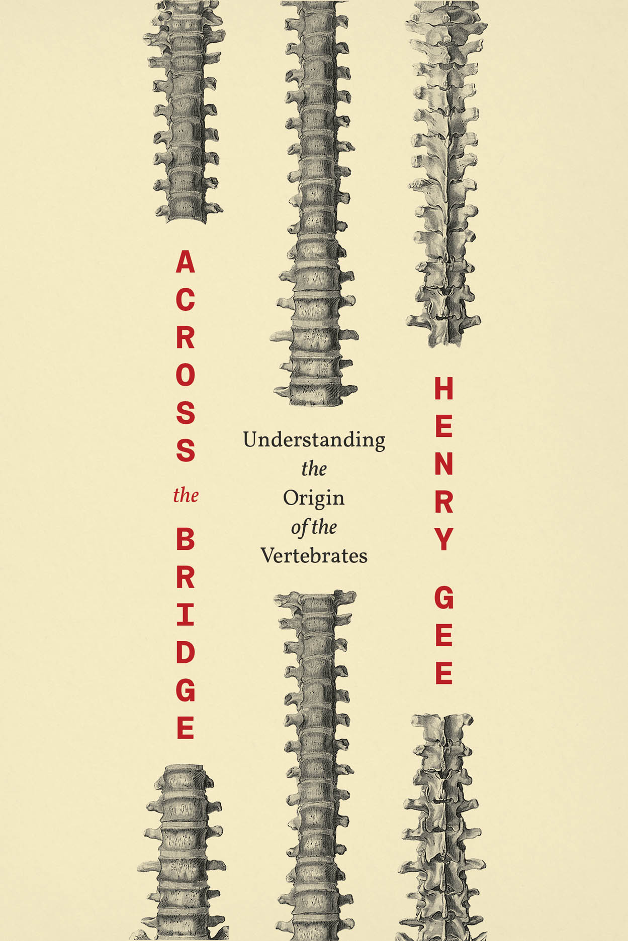Reviewed by David R. Cordie (Edgewood College, Madison WI)

Gee, H. 2018. Across the Bridge: Understanding the Origin of the Vertebrates. Univ. of Chicago Press.. 288 pp. ($17.40 paper, /$17.39 e-book with 40% PS discount.)
Across the Bridge by Henry Gee is a thorough exploration of a topic near and dear to the author’s heart. A follow-up to an earlier work by the same author (Before the Backbone published in 1996), the current piece explores new advances and concepts about the origins of vertebrates. Gee correctly states in the opening pages that the origins of vertebrates are often given little attention in many courses. Too far afield for invertebrate paleontologists and too early for vertebrate paleontologists, the discussion of where vertebrates came from and what they looked like is often summarized in a few slides (the reviewer is guilty of this as well), but Gee’s work seeks and succeeds in correcting this oversight.
The central thesis of Across the Bridge is clearly stated, that vertebrates are so unique, so bizarre, and so different from any invertebrate, that any attempt to group them with their nearest invertebrate ancestors is like comparing apples to onions. The author lays out a classical phylogenetic conundrum of long branches and how despite all life being related, some life has evolved and changed so greatly that it is difficult to see their resemblance. The author spends a great deal of time unwinding the historical placement of vertebrates as most related to creatures like Amphioxus (lancets) because of their more obvious encephalization, only for molecular phylogenies to instead place ascidians (tunicates AKA sea squirts) as sister taxa to vertebrates. Based on modern tunicates, this appears to be a ludicrous assertion, but Gee’s detail and evidence-based explanation of morphology, embryology, and genetics lays any doubt about this relationship to rest.
More of a textbook in novel form, the work does lack a strong chapter-to-chapter throughline. Readers looking for a Your Inner Fish-esque narrative will be disappointed. However, what is provided is well-written, informative, and filled with the author’s deep understanding and passion for the topic. The book starts with an introduction to the problem outlined above and several chapters on phylogenetics, embryology, and genetics to inform the reader of the basic tools being used by the author. Embryology and molecular genetics are heavily featured in this piece, but the terminology is not too onerous. After a few initial scrambles to uncover my Principles of Genetics textbook, I found the information provided to be very clear. Gee turns the mishmash of gene names into regular guests in the story. One example is the gene Nodal, which plays a major role in cell differentiation during embryogenesis, resulting in the handedness of deuterostomes (organisms such as echinoderms and chordates). Why does this matter? Because it is responsible for the asymmetry of our internal organs, such as our heart appearing on our left side. An example of a fascinating tidbit of information I had never known the answer to until this work.
The remainder of the book is a chapter-by-chapter description of various deuterostome organisms and their relatedness to vertebrates. As per the author’s main thesis, vertebrates are highly specialized deuterostomes and direct comparison between them often leaves us without obvious connections. However, new advances across numerous fields of study provide better results. Each chapter is well-organized, covering (in roughly the same order in every chapter) similarities in physical appearance, embryology, and gene sequences between echinoderms, hemichordates, Amphioxus, and tunicates to vertebrates. To pick out just one similarity, the author points out that pharyngeal slits are perhaps the best character to assess the origins of vertebrates. Though lost in modern echinoderms, all deuterostomes possess these filter feeding openings which provides the best evidence of their common ancestry based on a physical trait. These chapters might be belabored for newcomers to the field, but Gee provides succinct summaries at the end of most chapters and the final chapter provides highlights of key points for the entire book. A much-appreciated addition.
One downside of the work is that it is missing informative illustrations, especially when discussing anatomy or uncommon organisms. There are a few provided, as well as several phylogenies; however, the quality was a bit lacking in my opinion. Utilitarian in their presentation, I find myself wanting to redraft many of them should I plan to use them in a classroom setting. As far as to whom this book appeals, I think a general audience would be a bit lost by much of the information. This is more for a seasoned scientist who is an expert in their field, but not in the ways of early vertebrate evolution. Paleontologists are thrown a bone in the form of a chapter on enigmatic fossils of early vertebrates, but it is largely targeting biologists, in my opinion. Regardless, Gee is an undeniable expert in his field and for instructors wanting to beef up their lessons on tunicates and cephalochordates, I can think of no better work than Across the Bridge to consider.

